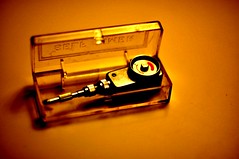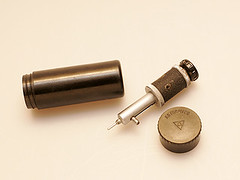Difference between revisions of "Self-timer"
m (Added some details about accessory timers) |
m |
||
| Line 2: | Line 2: | ||
Older mechanical self-timers, such as those on old [[Leica]]s or sold as accessory, typically employed some sort of a resistance coil. The user would pre-wind the coil to load it with tension, and then it would unwind. When it finished unwinding it would trip the shutter release. | Older mechanical self-timers, such as those on old [[Leica]]s or sold as accessory, typically employed some sort of a resistance coil. The user would pre-wind the coil to load it with tension, and then it would unwind. When it finished unwinding it would trip the shutter release. | ||
| − | Accessory self-timers can be used by screwing into the [[shutter release | + | Accessory self-timers can be used by screwing into the [[shutter release]] button; and most have the ability to adjust the trip mechanism length to match the specific camera. A special type are self timers that can be used for the [[cable release]] instead of the shutter release button. |
Modern electronic cameras use digital timers. Most digital timers have a set time (eg, 10 seconds) which counts down, giving beeps or flashing [[LED]]s as warnings, and then trips the shutter. Some electronic cameras offer the ability to select a desired length of time. | Modern electronic cameras use digital timers. Most digital timers have a set time (eg, 10 seconds) which counts down, giving beeps or flashing [[LED]]s as warnings, and then trips the shutter. Some electronic cameras offer the ability to select a desired length of time. | ||
Revision as of 16:26, 25 February 2021
A self-timer is a mechanism which is used to trigger the shutter after a set period of time - allowing the photographer to be in the picture, or to avoid vibrations introduced by fingers. This mechanism is either built into the shutter release of a camera or used as an add-on accessory.
Older mechanical self-timers, such as those on old Leicas or sold as accessory, typically employed some sort of a resistance coil. The user would pre-wind the coil to load it with tension, and then it would unwind. When it finished unwinding it would trip the shutter release. Accessory self-timers can be used by screwing into the shutter release button; and most have the ability to adjust the trip mechanism length to match the specific camera. A special type are self timers that can be used for the cable release instead of the shutter release button.
Modern electronic cameras use digital timers. Most digital timers have a set time (eg, 10 seconds) which counts down, giving beeps or flashing LEDs as warnings, and then trips the shutter. Some electronic cameras offer the ability to select a desired length of time.

|

|

|
| accessory self-timer by scenery_and_fish (Image rights) |
pneumatic accessory self-timer by Siim Vahur (Image rights) |
electronic self-timer by David Johnson (Image rights) |